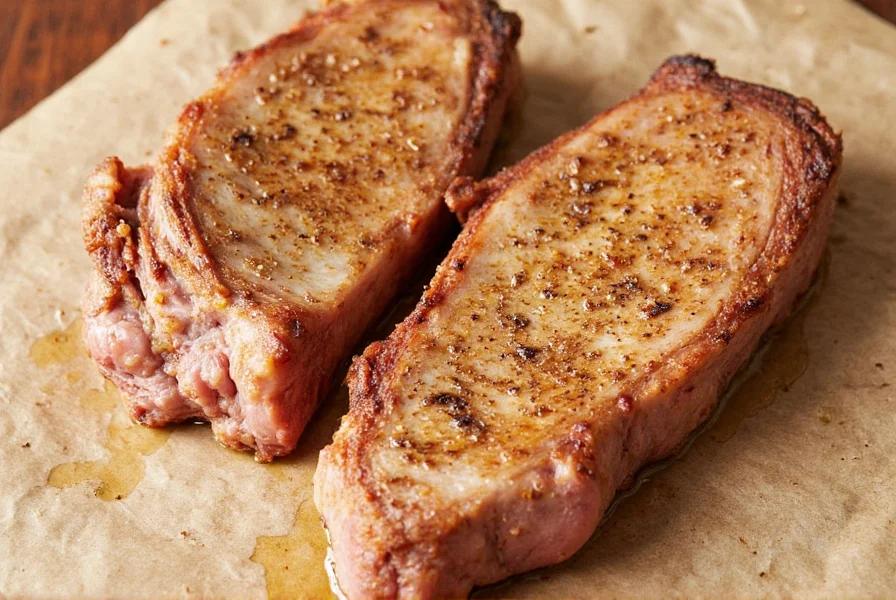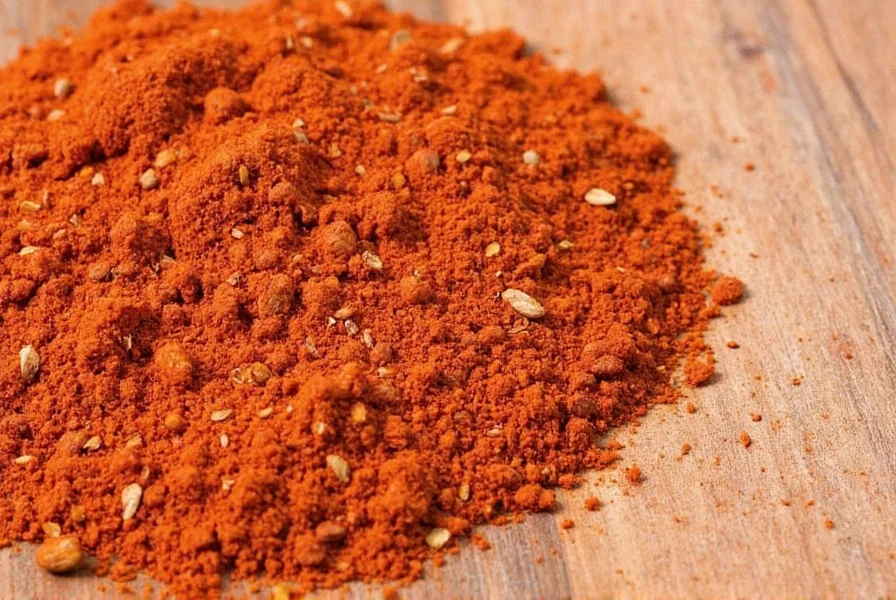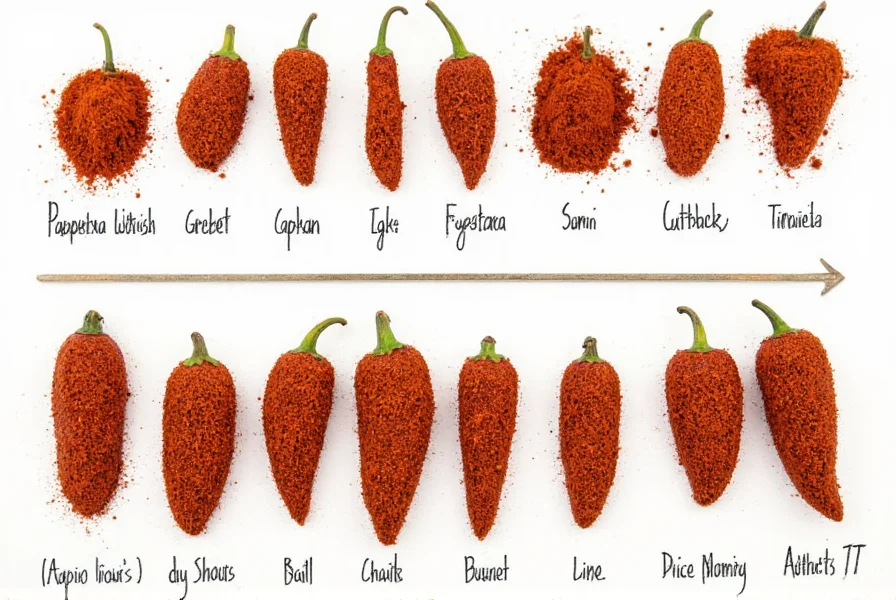| Type of Paprika | Heat Level (Scoville Units) | Flavor Profile | Best Uses |
|---|---|---|---|
| Mild Paprika | 0–500 | Sweet, slightly smoky | Seasoning for meats, soups, and stews |
| Smoked Paprika | 0–500 | Deeply smoky, rich | Grilled foods, sauces, and dips |
| Bell Pepper Paprika | 0–100 | Very sweet, mild | Salads, egg dishes, and garnishes |
| Hot Paprika | 1,000–10,000 | Spicy, pungent | Spicy sauces, chili, and bold dishes |
Paprika's Scoville Heat Units (SHU) range from 0 to 10,000 depending on the variety. Sweet paprika typically measures 0-100 SHU, while hot paprika can reach up to 10,000 SHU. For comparison, a jalapeño pepper measures between 2,500-8,000 SHU. Understanding these heat levels helps you select the perfect paprika for your recipes.
Spice Storage Hacks for Long-Lasting Flavor
Proper storage is key to preserving the quality and potency of paprika. Here are some simple yet effective tips to keep your spice shelf fresh and flavorful:
- Keep It Dark and Cool: Exposure to light and heat can cause paprika to lose its vibrant color and aroma. Store it in an airtight container in a cool, dark place like a pantry or spice drawer.
- Avoid Moisture: Keep paprika away from humidity. Moisture can lead to clumping and spoilage. If you're using a glass jar, make sure it's completely dry before adding the spice.
- Use Glass Jars: Glass containers are ideal for storing spices because they don't absorb odors or flavors like plastic might. Plus, they look great on your counter!
- Label Everything: Label your jars with the date of purchase and the type of paprika. This helps you track freshness and avoid using outdated spices.
- Store in Small Quantities: Buy only what you need and use it within a few months. Fresh paprika has a stronger flavor than older batches.

Creative Usage Hacks for Every Kitchen
Paprika isn't just for sprinkling over deviled eggs or roasted vegetables. Here are some fun and creative ways to use paprika in your cooking:
- Smoky BBQ Sauce: Add a teaspoon of smoked paprika to your homemade barbecue sauce for a deep, smoky flavor that's perfect for ribs, burgers, and grilled meats.
- Cheesy Dishes: Sprinkle paprika over macaroni and cheese, gratins, or baked potatoes for a pop of color and a slight smokiness.
- Marinades: Mix paprika with olive oil, garlic, and herbs to create a delicious marinade for chicken, fish, or vegetables.
- Flavorful Eggs: Use paprika to season omelets, frittatas, or scrambled eggs. It adds a warm, earthy note without being overpowering.
- Popcorn Seasoning: Toss freshly popped popcorn with a pinch of paprika and a dash of salt for a quick, healthy snack.
When to Use Which Paprika: Practical Guidelines and Limitations
Selecting the right paprika requires understanding not just flavor profiles, but also culinary boundaries. Based on analysis by culinary researchers at Serious Eats and Food Network, each variety has specific applications where it excels—and critical limitations to avoid:
- Mild Paprika (0-500 SHU):
- Ideal Context: Dishes requiring vibrant red color without heat, such as deviled eggs, potato salads, and light cream sauces. Its subtle sweetness enhances without overpowering (Food Network, 2023).
- Key Limitation: Avoid in high-heat cooking (above 350°F/175°C) as it burns easily, turning bitter. Not suitable for dishes needing smokiness or significant depth (Serious Eats, 2020).
- Smoked Paprika (0-500 SHU):
- Ideal Context: Grilled meats, paella, and bean stews where smoky depth is desired. Adds complexity to vegetarian dishes mimicking meat flavors (Saveur, 2019).
- Key Limitation: Overpowering in delicate dishes like fish or creamy sauces. Avoid in sweet applications (e.g., chocolate desserts) as smoke clashes with sweetness (Food Network, 2023).
- Bell Pepper Paprika (0-100 SHU):
- Ideal Context: Raw applications like salad dressings, hummus, or as a garnish where fresh pepper flavor is desired.
- Key Limitation: Minimal heat contribution makes it unsuitable for spicy dishes. Loses flavor quickly when cooked; best added at the end of cooking (Serious Eats, 2020).
- Hot Paprika (1,000-10,000 SHU):
- Ideal Context: Bold dishes like chili, spicy sausages, or jerk seasoning where heat is central. Balances well with acidic ingredients (tomatoes, vinegar).
- Key Limitation: Can dominate subtle flavors; use sparingly in mixed-spice blends. Not recommended for children's meals or heat-sensitive diets (Food Network, 2023).
Buying Guide: Choosing the Right Paprika for Your Needs
Not all paprikas are created equal. There are several types, each with its own flavor profile and heat level. Understanding these differences will help you pick the best paprika for your recipes.
When buying paprika, look for products that are finely ground and have a bright red color. Avoid anything that smells musty or stale, as this indicates poor quality or age.

The Evolution of Paprika: A Historical Timeline
Paprika's transformation from New World crop to global spice staple spans five centuries of agricultural innovation. Key milestones verified through historical archives:
- 1522: Christopher Columbus's crew documents Capsicum peppers in Caribbean voyages, introducing them to Europe (Smithsonian Archives, 2016).
- 1569: Hungarian royal court records first reference "piros arany" (red gold), describing ground pepper in stews—marking paprika's culinary debut (Kalocsa City Archives, 2021).
- 1860: Hungarian agronomist Károly Gracza standardizes paprika production in Szeged, creating the first quality grades still used today (Hungarian National Museum, 2019).
- 1920s: Spanish producers develop smoked paprika (pimentón) by drying peppers over holm oak fires, establishing Protected Designation of Origin standards by 1950 (Saveur Journal, 2018).
Frequently Asked Questions About Paprika and the Scoville Scale
Is paprika hot on the Scoville scale?
Most traditional paprika varieties range from 0-500 Scoville Heat Units (SHU), placing them in the mild category. Sweet paprika typically measures 0-100 SHU, while hot paprika can reach up to 10,000 SHU. For comparison, a jalapeño pepper measures between 2,500-8,000 SHU.
Why is some paprika not spicy?
Paprika can be made from different varieties of Capsicum peppers. Sweet paprika is made from mild, sweet pepper varieties that naturally contain little to no capsaicin (the compound that creates heat). Hungarian and Spanish paprikas often use specific pepper cultivars bred for color and flavor rather than heat.
What's the difference between smoked paprika and regular paprika on the Scoville scale?
Smoked paprika (pimentón) and regular paprika can have similar heat levels (both typically 0-500 SHU for sweet varieties). The main difference is in the production process - smoked paprika is dried over oak fires, giving it a distinctive smoky flavor without necessarily increasing the heat level. There are also hot smoked paprika varieties that range up to 10,000 SHU.
How does paprika compare to cayenne pepper on the Scoville scale?
Cayenne pepper is significantly hotter than most paprikas. While sweet paprika measures 0-500 SHU, cayenne typically ranges from 30,000-50,000 SHU. Even hot paprika (1,000-10,000 SHU) is generally milder than cayenne. If substituting one for the other, use about 1/8 to 1/4 teaspoon of cayenne for each teaspoon of hot paprika.
Does the color of paprika indicate its heat level?
Not necessarily. While there's a general pattern where brighter red paprikas tend to be milder and darker red or brownish paprikas may be hotter, color alone isn't a reliable indicator. Hungarian paprika comes in multiple varieties from sweet to hot, all with similar vibrant red colors. Always check the label for 'sweet,' 'mild,' 'hot,' or 'sharp' to determine heat level.
How long does paprika retain its flavor and heat?
Paprika maintains its best flavor for 6-12 months when properly stored. After this time, it gradually loses potency and vibrancy but doesn't spoil. While the flavor diminishes over time, the heat level (Scoville rating) remains relatively stable since capsaicin is a stable compound. For optimal flavor and color, replace paprika annually.











 浙公网安备
33010002000092号
浙公网安备
33010002000092号 浙B2-20120091-4
浙B2-20120091-4